Jefferson
Airplane
Albums reviewed on this page: Surrealistic
Pillow, After
Bathing at Baxter's, Crown
of Creation,
Volunteers,
Blows
Against the Empire, Hot Tuna,
Bark,
Sunfighter, Papa
John Creach,
First Pull Up, Then Pull Down,
Fat
Fandango, Child of Nature.
Jefferson Airplane was one
of the best San Francisco bands but
also one of the most consistently commercially successful outfits of
the late 60s and 70s, although you would never know it today.
Sure, everyone is familiar with their two big hits, "Someone to
Love" and "White Rabbit," but starting with the album
from which those songs were drawn , Surrealistic Pillow,
the
lowest chart position one of the albums reached was 20. That
makes eight Top 20 albums in a row. Why
don't we hear
this music? Because despite that success none of their
singles
ever did much in the charts, and I guess DJs realized that most of
the album tracks are awful, plus commercial radio (at least in the
US) is almost entirely driven by catering to people's nostalgia for
old singles. The more important issue is whether or not we
want
to hear this music. For the most part, the answer is
no.
The band's folk + acid thing was impressive while they stuck with it,
but they quickly turned into spokespeople for their
generation.
That meant anti-war left-wing politics, bad folk jams and a graduated
rootsier style. By being so much in the moment, the
Airplane's
later albums have become permanently stuck in it, sounding horribly
dated today. When all was said and done, the band had their
own
vanity label, Grunt, which allowed them to release solo albums of
varying sort and quality, and diminished sales. The band
broke
up in 1973, only to sort-of reform as Jefferson Starship the next
year. But back at the beginning JA was a very good
folk/acid-rock band, mixing straight music with psychedelic
runs.
One of their most notable features early on was their strong mixed
vocals, which made them sound like the Mommas and the Poppas, if that
group rocked. Their breakthrough album Surrealistic
Pillow
does a very good job of mixing in psychedelia (usally through Grace
Slick), while After Bathing at Baxter's is more
given over to
aimless noise jams. They recovered to the general quiet folk
feeling on Crown of Creation but then began a long
slide
downward through the Land of No Hooks with a few rounds of Where's
the Melody? as they became encumbered by the roots-rock
movement.
Most of their musical edge was planed off with this excessive good
time, return to the country feeling. Sure they did odd things
like take on an older violin player, but the retreat from the
idealism of the 60s was echoed in the Airplane's music (or funneled
into the hippie science fiction of Paul Kanter). They were
the
voice of their generation, but it was one that became disillusioned,
although not with the band (as their success showed).
Here is a quick rundown on
the individuals that make up Jefferson
Airplane. Balin really shared most of the lead vocals early
on
and had some good songs, but he faded out over time. His
voice
is bit quirky as well. Kantner, recipient of my John B.
Sebastian look-alike award was mainly a rhythm guitarist and
reasonable singer. He wrote the majority of the group's later
songs, but for the most part they sound awful today, and the same
goes for most of his solo work. Kaukonen was the true lead
guitarist among them, playing both the usual bluesy licks, and also
intricate folk lines. Jack Casady was America's best bassist,
playing great lines and pioneering a big fuzzy sound. He
combined this distinctive sound with Kaukonen 's own old-time folk to
form the spin-off group Hot Tuna, which is pretty much what you would
expect. Finally, Grace Slick is probably the most well-known
member of the group due to her gender and lead vocals on the group's
hits. She was not a belter a la Joplin, but can go for a nice
normal sound, or seductive, or angry or sadistic or so darn strong
you'd feel she was yelling for them to crucify someone. In
case
you think I forgot the drummers, they were the most varying of the
lot, from simply decent to good and they generally had a jazz
background. That was probably entirely useless, but I thought
I
would make the effort. Oh well.
Personnel: Signe Anderson
(vocals), Marty Balin
(vocals, guitar), Paul Kantner (guitar,
vocals), Jorma
Kaukonen (guitar, vocals), Skip Spence
(drums), Jack
Casady (bass). Anderson and Spence
left after Takes Off
didn't, and Spence then helped found Moby Grape. They were
replaced by Grace Slick and Spencer Dryden,
respectively. After Volunteers, Dryden
left, was
replaced by Joey Convington. Let's see, Papa
John
Creach (violin) joined 1970, Balin quit
1971. But by
Long John Silver, Covington had
been replaced by John
Barbata, and David
Freiberg
(bass) was also made male lead singer. This takes me to 1973,
where I will stop for right now.
Jefferson Airplane
Takes Off (1966)
No
Grace Slick, and
the drummer Skip Spence was a converted guitarist. This
scraped
the bottom of the charts. This LP destroyed my needle.
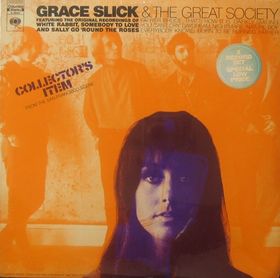 The Great Society: Collector's Item (rec. 1966, rel. 1968)
The Great Society: Collector's Item (rec. 1966, rel. 1968)
This
collects two live albums recorded by Slick's pre-Airplane group the
Great Society. I don't have too much to say about it - the
liner notes suggest the Great Society were probably a good band for
their time, but only because the competition was so weak. The
group plays well together, but the recording dumps the band in one
channel and Grace in the other, making it annoying to listen to with
headphones. Supposedly the group had two guitarists - I only
hear one (Darby Slick?) who is a great rhythm player and then chokes
on solos. Kind of funny hearing him try and cover up his
mistakes through repetition. Anyways, the real reason someone
might want to hear this is for the originals of "Somebody to
Love" which is less expansive here, and "White Rabbit"
which gets an interesting extended Egyptian introduction.
Otherwise the band played contemporary folky guitar-rock in a
standard form, with Grace's distinct vocals and her husband's
eighth-note loving drumming. Produced by Peter Abram.
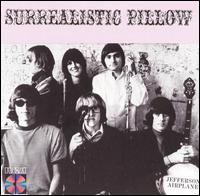 Surrealistic
Pillow (1967), ****
Surrealistic
Pillow (1967), ****
With
a few personnel changes, the Airplane released one of the best
pre-Sgt. Pepper albums of the era.
Mid-tempo rock with
grumbly bass (Jack Casady), Byrds-like harmonies (see the Mammas and
the Poppas) and blues-based electric solos all power this album above
most anything else from the period. Grace Slick is only one of the
driving forces on Surrealistic Pillow - charging
through the
psychedelic hits "White Rabbit" and "Somebody to
Love", and proving that America really did contribute something
to the music scene. I am not sure if there was a lead
vocalist,
with 4 people credited to vocals, and 3 to guitar, and everybody
contributing at least one song. The album's only weak numbers
are "Comin' Back to Me" which looses its effectiveness at
over five minutes, and the obligatory Airplane-imitating-Paul
Simon-imitating-Dylan number "Plastic Fantastic Lover".
Otherwise, Surrealistic
Pillow is pretty diverse: the
fast-paced hits are
offset by slower folky numbers, with plenty of good songs in-between
(the opening song "She Has Funny Cars" combining the best
of all). Hell, the album even includes a fairly brief,
interesting acoustic solo "Embryonic Journey".
Excellent, and fun. Produced by Rick Jarrard. Jerry
Garcia also has a hand in the album as "Musical and Spiritual
Advisor," whatever that means.
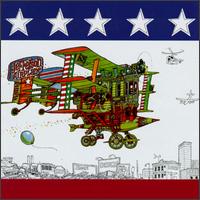 After
Bathing at Baxter's (1967), ***
After
Bathing at Baxter's (1967), ***
After
flirting with
psychedelia on Surrealistic
Pillow, the Airplane dove in
head-first, but with
mixed results. Gone are most of the acoustic guitars,
replaced
with electric on full distortion (inspired by their own
bassist?).
The experimentation does not do much for the album - there's a short
sound collage ("A Small Package of Value Will Come to You,
Shortly"), and they play around with the speed of the recording
at points ("Young Girl Sunday Blues"). Additionally,
the songs are divided into groups, with names like "Street
Masse". But they fail to capitalize on the success of
Slick's vocals, and she has sings lead on two songs again.
One,
"rejoyce", is a mysterious social commentary, and the
other, "Two Heads", has those full-throated vocals, but is
not as good as those on Surrealistic Pillow.
That is
After Bathing at Baxter's big problem: most of the
songs
aren't as focused or good, with the exception of the updated acoustic
"Martha" or the vocal harmony weirdness of "Won't You
Try". The low point is a nine+ minute hypnotic jam between
the bassist Casady, one of the guitarists and Dryden ("spare
chaynge"). Paul Kantner wrote most of the songs, I still
don't know what guitarist does what, but I do know that Jack Cassidy
was one of America's best bassists. Produced by Al Schmitt.
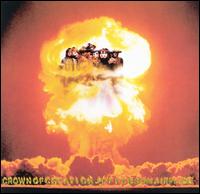 Crown
of Creation (1969), ****
Crown
of Creation (1969), ****
Half
of this
album is near perfect. Instead of loading up on psychedelic
production, the Airplane delivered a string of moody, slower-paced
acid-folk songs (the highlight being David Crosby's donated "Triad",
which is so damn well arranged and sung [by Slick] that it's
scary).
The album has plenty of fine electric acid-rockers, from Balin's
wailing "Share a Little Joke" to Kaukonen's "Star
Track", to the title track by Kantner, which also displays their
group harmonies at their fullest. The Airplane is still
experimenting a bit, but outside of Dryden's mercifully short sound
collage ("Chushingura") it is tastefully done (Slick's
"Lather" which incorporates both recorded sound bites as
well as a solo which sounds like a person on drugs attempting to
imitate a guitar). The band does have some issues underneath,
which have not turned into problems yet, but still could.
Despite having three guitarists, none of them is really an
out-and-out soloist (Kaukonen may have been tripped out).
Instead, Crown of Creation has a lot of rhythm
playing, and on
the electric songs usually some fairly slight pentatonic soloing
(Balin's jaunty "If You Feel"), sometimes with another
guitar contributing some single note verse accompaniment which is not
quite diddling ("Star Track"). Casady may be the only
consistently fantastic instrumentalist, but the songwriting talent of
the rest of the group is what really shines here. Crown
of
Creation drops off during its second half, with Slick trying
again to do her angry, strident vocal thing ("Greasy Heart")
and an an extremely boring, gloomy apocalyptic-rock song ("The
House at Pooneil Corners", which alternates between two chords
for
the most part).
As long as you know when to cut it off (right after the title track),
this is an excellent album. Otherwise, it is merely
good.
More proof that the Airplane was a rare group with multiple good
songwriters. I once believed a line from "Triad" may have
been the inspiration for the title of the Big Star album Sister
Lovers. Produced by Schmitt again.
Perhaps
I'm just off
my acid-rocker.
Bless Its Pointed
Little Head (1969)
A
live album.
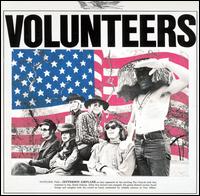 Volunteers
(1970), **
Volunteers
(1970), **
It
is pretty clear
that the Airplane decided to go rootsy like most of their fellow
bands. But on Volunteers their playing
ability starts to
the
limit them.
In fact, one thing that really sinks this album is the cursed
distorted guitar that pops up in almost in the right channel on
almost every track. Whoever it is (Kantner? Kaukonen? Balin?
some combination?) has a mastery of the basic pentatonic scale, but
only that. It gets real annoying real quick, as the mystery player
does not stumble across anything really interesting. They did
have enough sense to bring in Mr. Good Timey Piano himself, Nicky
Hopkins, for a number of tracks, but the level at which they
rely
on him for their sound is a bit unsettling for a band with three
guitarists (although I wouldn't be surprised if Balin didn't
play
on the album, so maybe two guitarists).
But for the most
part Volunteers does not work. Their
country-rock is
iffy at best (Kantner's goofy "The Farm" with Jerry Garcia
on pedal steel, or Dryden's band-breakup tune "A Song For All
Seasons" with traditional massed vocals). CSN's influence
is really apparent - both in an inferior version of "Wooden
Ships" with a written intro by Kantner, and Kaukonen's "Turn
My Life Down", an on-the-money impression of a Stills gospel
song (with organ by the man himself). Otherwise, Slick
returns
to her cold, dark ways on her "Hey Frederick", only to have
the track turned into a real nightmare by a lengthy instrumental coda
featuring a guitar battle with both sides playing
the
distorted pentatonic game. Political feelings and slogans
turn
up more in the packaging (a mock newspaper including insert) than in
the songs themselves (Kantner's steady and remarkably normal "We
Can Be Together" and the Balin-Kantner title track which is
perfectly suited for audience participation, but lacks more that two
chords). Plenty of good moments, but only one
really good
song, "Turn My Life Down". The rest is not dreck, but
a lot of professionally done ho-hum material. Covington
appears
in a couple of places. Produced by Schmitt.
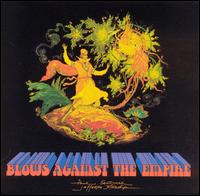 Paul
Kantner/Jefferson Starship: Blows Against the Empire (1970),
**
Paul
Kantner/Jefferson Starship: Blows Against the Empire (1970),
**
Poor
Paul Kantner. There was no way for he and his friends to know
that their starry-eyed optimism and taste in modern literature would
sound incredibly dated today. His enthusiasm really blows
through this album, but any project that could be seriously subtitled
Hippies in Space seems ripe for mocking. Blows
Against the Empire is supposed to accompany a novel of the
same
name, which may or may not exist, and its story deals with hippies
hijacking a starship so they can be free among the stars. Try
not to think about it too hard. Throughout all Kantner plays
guitar and bass, and the ever present Slick contributes piano and
vocals. Throw in a pile of guests and the whole thing reeks
of
"vanity project," but that should not necessarily condemn
it. What does condemn it is the fact that Kantner is plainly
not a good songwriter. He wrote a trio of songs with semi
meaningless and self-consciously literate lyrics (but nowhere near
Jethro Tull standards)
and then crafted
loose backing around them ("Mau Mau <Amerikon>",
"Hijack", "Starship") that are classic examples
of sprawl without hooks. The one song he had no hand in
writing, "Baby Tree", is done with simplicity (a solo banjo
arrangement) and directness. Out of the pile of guests, David
Crosby co-wrote the better songs ("A Child Is Coming" with
a cool "it's getting better" segment, and "Have You
Seen the Stars Tonight" which is rather calm comparatively),
while when left to himself, Kantner cranks out the same old mediocre
folk dribble ("Lets Go Together"). Let's not forget
the by-now obligatory sound collages, where one learns that
spaceships sound like feedback and vacuum cleaners ("Home",
"X-M"), but without any homage to Our Man in Havana.
Blows' biggest surprise is that
Slick turns out
to be a competent, if not outstanding pianist ("Hijack").
The guests include the entire contemporary Airplane lineup (Kaukonen
delivers some nice wah-wah work on "Mau Mau <Amerikon>",
and Balin contributed some lyrics), Crosby, Nash, Jerry Garcia (who
blows through some nice leads on "Starship"), both Dead
drummers, Harvey Brooks,
and
David Freiberg.
Among those
thanked are Kurt Vonnegut, Jean Genet and A.A. Milne, all of whom
wrote far better than these guys. This album dares to dream,
but like so many pot inspired dreams its wisdom has turned out to be
worthless. As proof of how hot the Airplane was commercially
(while coasting artistically) this reached #20 in the charts.
 Hot
Tuna: Hot Tuna (1970), ***1/2
Hot
Tuna: Hot Tuna (1970), ***1/2
A set of
old-time country-blues (pre Chicago, pre Delta, pre R&B stuff -
the sort of material that would sound at home on a banjo) performed
by Kaukonen (on acoustic) and Casady, and sometimes augmented by a
Will Scarlett on low-key
harmonica. Recorded live in a club, the
performances
are unhurried, and Kaukonen's vocals are lackadaisical
throughout.
Hot Tuna's production is pretty flat, which is to be
expected
in the circumstances, but Kaukonen's guitar technique is impressive,
and Casady always pleases. It may just be the setting, but it
even sounds like Casady is slapping his bass in places. The
songs themselves do not vary much, with the Rev. Gary Davis's "Death
Don't Have No Mercy" obviously being a basis for Crown of
Creation's "Star Track", and Jelly Roll Morton's "Don't
You Leave Me Here" being a personal favorite. But this
album is specific in its sound that one will either love it or be
bored to death. If the latter is true then all the defects
will
stand out - flat sound, low energy, little songwriting (Kaukonen only
contributes a couple of tracks), repetition. Whatever the
case,
it certainly is a departure from the mainline Airplane sound, even if
it requires an acid test (no pun intended).
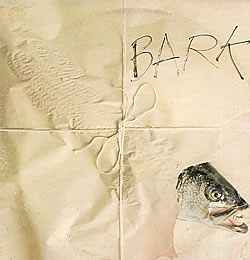 Bark
(1971), **1/2
Bark
(1971), **1/2
Tons
better than Volunteers, Bark is
coherent, well-played
and the band reigned themselves in. With both Balin gone and
Kantner occupied with side projects, the
rest of the Airplane has plenty of
opportunity to get
songs on an album. Plus, you can discern each member's role -
Kaukonen is the lead guitarist, Slick is on piano, and Papa John
Creach is lurking in the background on violin somewhere.
Kaukonen was developing into a great electric blues-rocker ("Feel
So Good") and Bark has a couple of good tracks
that could
be from a Hot Tuna album (the acoustic "Third Week in the
Chelsea" might be from Hot Tuna, and "Wild Turkey"
foreshadows their electric work with Creach). Kantner
contributed his usual epic smiley-faced anthems, stuff the Iranians
might sing as they gleefully walked arm-in-arm across minefields
during the Iran-Iraq war ("War Movie" where he stumbles
across the annoying siren sounds that would later punctuate ELP's
"Rondo"). Sure, his sci-fi interest is sort of odd
("When the Earth Moves Again", "Rock & Roll
Island"), but give the guy credit for being unusual, and his
songs are at least tolerable this time. Slick's compositions
are pretty standard as well (confusing
social commentary on "Crazy Miranda" and "Lawman"
is a fine bluesy rock song),
although her
piano skills improved. The Airplane's goofy side is more
pronounced, and concentrated in a few songs, such as the
endurance-test "Never Argue With a German If You're Tired",
with Slick singing mock German, and some odd studio noises and tape
effects in the background, as if someone had replaced the tapes in a
mellotron with those of opera singers and began to mess around on
it. Covington's "Thunk" is unexpected, but not as
bizarre: an experiment in self-multi-tracked vocals that attempts to
update goofy doo-wop music in a capella style.
However, Bark's true surprise is "Pretty As You
Feel",
also the Aiplane's last hit. The song is so deliberately
low-key, with distinct vocal harmonies and light guitar and violin
lines running throughout that you'd think it was anything but a
Jefferson Airplane track at heart. Almost like a CSN song
with
Santana appearing on guitar alongside Stills. More of group
album than before, and with surprisingly good results.
Produced
by the band.
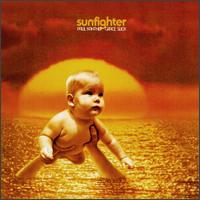 Paul
Kantner/Grace Slick: Sunfighter (1971),
**
Paul
Kantner/Grace Slick: Sunfighter (1971),
**
Apparently
another chapter in the Blows Against the Empire
saga, but
since my copy lacked a libretto booklet (their term, not mine) I
cannot be entirely sure. One thing is for certain - Sunfighter
is worse. All of Kantner's previous indulgences are
present but without others to shore up the music, although the usual
suspects are around. Kanter was up to his old rambling thing
as
Sunfighter has a lot of talk about San Francisco,
children
living with wolves, cannibalism, trips to Andromeda and the
like.
Kanter also (sometimes with Slick) wrote a large pile of mediocre
folk numbers, some of which demonstrate his interest in goofy
rusticity ("Look at the Wood"), or mid-tempo rock songs
that goes runs in circles while he babbles off odd lyrics ("When
I was a Boy I Watched the Wolves"). Plus, his tendency to
fall off pitch when holding a note is really annoying. Slick
is
more interesting -- she still can be utterly captivating with her
vocals ("Silver Spoon") which she never got to do Blows,
and her "China" is a remarkably well thought out ode to
her (and Kantner's) baby, and stands far (or is held) above
everything else on here. It isn't a real shock that Sunfighter
sounds like an Airplane album - nearly everyone from the group showed
up, and includes the requisite amount of "experimentation"
that contribute little ("Universal Copernican Mumbles", or
the sonic recreation of "Titanic", some background
synths). The album also ends in the worst possible way - a
long, tepid, horribly loose and ironically titled "Holding
Together" which gives Kantner plenty of time to blather his way
through ridiculous lyrics, while the absence of solos is absolutely
oppressive. The only thing, and I mean the only
thing
that is worth listening to on that track is the strange bass
(synthesized?)/guitar unison that sounds like a sax buried in the
mix. Other than that, forget the song, and other than the two
Slick songs, forget the album.
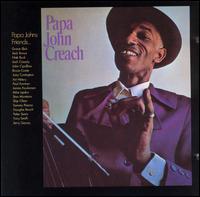 Papa
John Creach: Papa John Creach (1971),
***
Papa
John Creach: Papa John Creach (1971),
***
Papa
John Creach's tale is one made for a VH1 special: a band at their
commercial zenith adding a far older and completely
unknown session musician. The move
really makes a
lot of sense: the Airplane had been getting rootsier with Volunteers,
and outside projects like Hot Tuna reinforced the old-time
streak.
Creach was a old session violin player from the jazz/blues side of
things, and he had an interesting impact on the Airplane.
Everyone who was, or had been, involved with the Airplane at the time
got to record solo albums or have side projects, and Creach was no
exception. Similar to his fellow flyers, Papa John
Creach
has a laundry list of San Francisco musicians, but the
album's
sound is different from the Airplane's revivalist tendencies, as
Creach brings more of R&B and blues feeling to many
tracks.
Like many good session people, he had his own distinct style of
playing, and his electric violin really sings. He did deliver
some fine instrumental renditions of standards (Dixieland on "St.
Louis Blues", "Danny Boy", and a beautiful rendition
of "Over the Rainbow"). Some tracks are Hot Tuna in
everything but name ("Plunk a Little Funk", "String
Jet Rock"), and others have a distinct R&B feel ("Soul
Fever", Covington's "The Janitor Drives a Cadillac"
which made the Top Forty). He even coaxes a marvelous
performance out of Carlos Santana on some late 50s rock and roll
("Papa John's Down Home Blues"). But while the
players are impressive (the full lineup of Jefferson Airplane and Hot
Tuna around, some Santana members and lesser appearances by John
Cipollina and Jerry Garcia), the most amazing thing is not
that
he was able to rope in all of these people, but that they sound
really comfortable playing together. Listening to Papa
John
Creach is a good time - it has a lot of feeling and emotion
behind it, despite the paucity of original material. If you
cannot get enough Hot Tuna, this would be a good place to
look.
Self-produced.
The
real reason the
album is so successful? Paul Kantner is limited to only one
rhythm appearance, and doesn't write anything. (Yeah, I'm a jerk.)
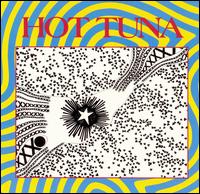 Hot
Tuna: First Pull Up, Then Pull Down (1971), ***
Hot
Tuna: First Pull Up, Then Pull Down (1971), ***
Still
lingering between side-project and full-fleged band, Hot Tuna
encompassed drummer Sammy Piazza and the Airplane's Creach to round
out the sound for this live set. Thus, Kaukonen's acoustic
country-blues of their debut now takes its place alongside electric
blues-rock, and the addition of more players allows everyone to
stretch out more. Including three old timey blues tracks ("Candy
Man", "Want You To Know", "Never Happen No More")
is a bit much, given that they all sound pretty much alike: laid back
Kaukonen vocals and melodies that would be apt for banjo
accompanyment. Creach's violin fits in perfectly on these songs,
conjuring up more of their original trappings. It may have been novel
for a rock group to reach this far back for their material, but Hot
Tuna's adherence to traditional melodies means that repetition
overshadows the novelty since their focus is on the music, not the
lyrics. This aggregation of Hot Tuna shines the best when they go for
the other tried and true - the regular blues. Most of these songs are
just loose structures so the band can jam ("John's Other",
"Come Back Baby" and "Keep Your Lamps Trimmed and
Burning"). Only "Been So Long" is the exception, as it
is presented as short blues-rock tune. A few minutes into "Keep
Your Lamps Trimmed and Burning" the band noticeably tightens up
and starts playing with an intensity not matched elsewhere on the
record, so much that Scarlett and Creach get left behind.
Essentially, this is a bunch of very good musicians doing some very
disciplined jamming to a bunch of covers. However, the band makes
little attempt to integrate this sound with anything else, unlike Dan
Hicks's historical alchemy. The narrow scope of Hot Tuna's sound
(wouldn't want to compete with the Airplane now) as opposed to other
Bay area bands means blues and blues-rock fans will probably be
delighted, and others will not understand the attraction.
Long John Silver (1972)
Their
final album, and every one of them after Takes Off
made it to
the top 20.
Hot Tuna: Burgers (1972)
Studio
recording. Reportedly the key Hot Tuna album, and one that I also
own.
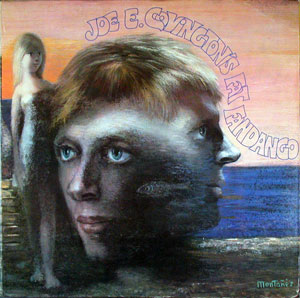 Joe
E. Covington's Fat Fandango (1973), ***1/2
Joe
E. Covington's Fat Fandango (1973), ***1/2
The
existence of a Joe E. Covington solo album shows just how popular the
Airplane were at this time. If Creach was a known quantity,
Covington has to have been the group's extreme X factor. Joe
E. (or Joey as we'll call him from here on out) is right behind Signe
Anderson on the list of least recognizable Jefferson Airplane members
(hush J. Peloquin fans), and a drummer to boot (drummers' solo
careers being notoriously hard to predict [hush P. Collins
fans]).
The one huge difference between this album and the rest of the
fragments spinning out from the artistically imploding Airplane was
that Covington had the decency to avoid any famous guests on his
album. To clarify, Covington uses a stable band and is
himself
the most famous person around. Follow this ? with an extra !
then. He seems to have been a pretty quirky guy - mixing the
pleasant California feeling with 50s doo-wop/early Motown and
art-rock, or sometimes both ("Miss Unaverse"). The
playing is excellent, which is good considering the rather strange
combinations of these songs. The great opening track, "Your
Heart is My Heart" sounds like early Temptations but with some
great psychedelic guitar work by Stevie Midnite thrown in.
The
real catches are where he lets the band get into a loose groove, and
the organ work of "Senator" Patrick Craig propels the music
into Canterbury territory ("Mama Neptune", "Miss
Universe"). It is all held together by
Covington's tongue-in-cheek humor that echoes Zappa in places (the
Hendrix-flavored funk "Hideout (Is a Crook's Best Friend)"),
but nobody is around to tell him when to stop (the cloying 50s ballad
"Moonbeam" with Covington just belting out his vocals).
His drumming is uncluttered, fast jazz work, but his voice is often
the key component (as like lots of drummers he wants to sing as well
[hush C. Palmer fans]). Although he had a good range in the normal
registers, is voice is kind of thin - think Joe Walsh at his best
(the fun "Country Heart"). Which is why it is a good
thing that he goes all nostalgic, because he overdubs well with
himself, and the 50s material provides ample opportunity for him to
use his good falsetto. One man's wacky vision should be
chalked
up as a winner, although you'll probably never see or hear
it.
The bassist is Jack Prendergast. Produced by Covington and
Pat
Ieraci.
He's
also kind of mad
in real life because he didn't get into the R&R Hall of Fame
with
Jefferson Airplane.
Paul Kantner, Grace Slick and
David Freiberg:
Baron Von Tollbooth & the Chrome Nun (1973)
I
have a feeling that the joke is on us.
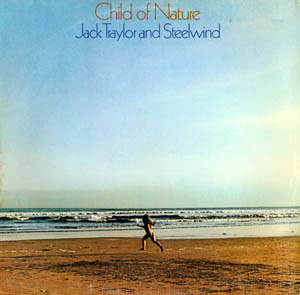 Jack
Traylor and
Steelwind: Child of Nature (1973), **
Jack
Traylor and
Steelwind: Child of Nature (1973), **
A
basic desire of any species is reproduction, and occasionally the
urge strikes bands as well. Paul McCartney became the
surrogate
father of Badfinger and helped kick off the nostalgia influenced
power-pop of the 70s, while Jefferson Airplane step-parented
Steelwind. It is almost simple one-to-one substitution - Jack
Traylor was the main songwriter and vocalist, and sticks to
unvarnished acoustic rhythm guitar (Kantner).
The have a
female vocalist, Diana Harris, who also happens to play some piano
(Slick), a lead guitarist who mainly sticks to
electric
(Kaukonen), a third guitar player, Skip Morairty (Balin),
and a bassist (Casady). Plus, longtime
Airplane producer Al Schmitt produced their debut, Child
of Nature. Sure, it is not quite that
simple, and
this comparison is far more interesting than Steelwind's
music.
I wish I would stop running across these albums from the Airplane's
vanity label, Grunt. Traylor's an okay singer/songwriter (the
title track is catchy) but outside of Chaquico, who later hald the
same position in Jefferson Starship, the group's backing is vanilla
folk/soft rock stuff (plenty of lame 70s flute courtesy of Skip
Morairty). When they did pick things up a bit, Steelwind
sounds
like an Airplane knockoff (the politically themed "Smile",
"Gone to Canada"). The young Chaquito gets in some
nice work , and has one extended solo which owes a lot more to flashy
rock than folk ("Time to be Happy"), but beyond that your
pulse will not rise too much. Child of Nauture is instantly
forgettable, pleasant 70s music, but its dated political content
insures that it will not be played in a bank lobby near you anytime
soon. Besides Traylor and Chaquico, the other members of
Steelwind dropped off the face of the planet. The drummer is
Malo member Rick Quintanal, and Freiberg plays faint mellotron on one
track. "Caveat Emptor" indeed.
I
refuse to buy Jefferson
Starship albums, because I don't think I would get anything out of
them. Just my (arbitrary) line in the sand.
Where
are the bodies for dinner?...on the Music Page. Yum.
 The Great Society: Collector's Item (rec. 1966, rel. 1968)
The Great Society: Collector's Item (rec. 1966, rel. 1968) Surrealistic
Pillow (1967), ****
Surrealistic
Pillow (1967), **** After
Bathing at Baxter's (1967), ***
After
Bathing at Baxter's (1967), ***
 Crown
of Creation (1969), ****
Crown
of Creation (1969), ****
 Volunteers
(1970), **
Volunteers
(1970), **
 Paul
Kantner/Jefferson Starship: Blows Against the Empire (1970),
**
Paul
Kantner/Jefferson Starship: Blows Against the Empire (1970),
**
 Hot
Tuna: Hot Tuna (1970), ***1/2
Hot
Tuna: Hot Tuna (1970), ***1/2
 Bark
(1971), **1/2
Bark
(1971), **1/2
 Paul
Kantner/Grace Slick: Sunfighter (1971),
**
Paul
Kantner/Grace Slick: Sunfighter (1971),
**
 Papa
John Creach: Papa John Creach (1971),
***
Papa
John Creach: Papa John Creach (1971),
***
 Hot
Tuna: First Pull Up, Then Pull Down (1971), ***
Hot
Tuna: First Pull Up, Then Pull Down (1971), *** Joe
E. Covington's Fat Fandango (1973), ***1/2
Joe
E. Covington's Fat Fandango (1973), ***1/2
